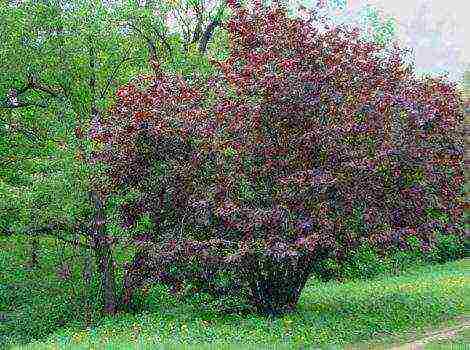What could be tastier and healthier than fresh cucumbers grown with your own hands in the garden or in the country? And if there is neither one nor the other, but there is a corner on the balcony - the only free space in a small city apartment? Also a suitable place for a small vegetable garden! It is very convenient to take care of him without leaving home. Why cucumbers do not grow on the balcony, the reasons and options for how to fix this will be described later in the article.
Conditions for a good harvest of cucumbers
Indoor cucumbers, if they are considered shade-loving plants, then only relative to those that grow outdoors. You should try to provide them with as much light as possible.
Therefore, it is strongly discouraged to place a "garden bed" on a northern or tree-shaded balcony, on which the sun never peeps.
With artificial lighting, summer cucumbers will also grow, but natural light is better for them. However, you should not neglect the lamps in winter, as well as on cloudy autumn days.
to contents ↑ Temperature and humidity
From too hot, direct sun (about 30 ° C), the leaves also need to be covered.
Since we are talking about summer cultivation, it is necessary to maintain a slightly increased air humidity on the balcony, for this, put a bucket of water next to the "vegetable garden" and spray the air from a spray bottle at least once a day.
Varieties intended for closed spaces are characterized by sensitivity to temperature changes and drafts, therefore, it is desirable that there be glazing. If the winds are rare and not strong and there is no great heat, it is enough to hang a curtain made of foil to hang it when needed.
to content ↑ Capacity
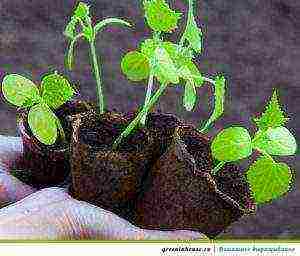 The capacity for cucumbers should be such that for each plant there is at least 5 liters of soil at a depth of at least 10 cm.The roots of this culture grow in the upper layers, they do not need much depth.
The capacity for cucumbers should be such that for each plant there is at least 5 liters of soil at a depth of at least 10 cm.The roots of this culture grow in the upper layers, they do not need much depth.
Standard containers for flowers measuring 25 X 80 cm are convenient, 2 developed bushes will bear fruit well in them.
A flower pot will work for one instance, and why not use a leaky pan? Holes in the bottom, a drainage layer, a sump for excess water during irrigation - everything is done as is customary according to the rules of potted floriculture.
to the content ↑ Soil for growing cucumbers
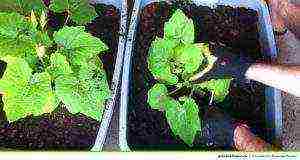 Cucumbers need fertile soil. It can be bought in a store or prepared by enriching the soil taken from the garden with mineral and organic additives. River sand is added to improve the structure. The composition can be as follows: garden soil (previously disinfected by calcining), peat, river sand in a ratio of 4: 1: 1 and a glass of charcoal at the rate of 5 liters of the mixture. Be sure to water the soil well before sowing.
Cucumbers need fertile soil. It can be bought in a store or prepared by enriching the soil taken from the garden with mineral and organic additives. River sand is added to improve the structure. The composition can be as follows: garden soil (previously disinfected by calcining), peat, river sand in a ratio of 4: 1: 1 and a glass of charcoal at the rate of 5 liters of the mixture. Be sure to water the soil well before sowing.
back to contents ↑ Sowing and growing seedlings
To harvest during the summer, you need to start sowing in the room, in late April - early May. It is important to coordinate your actions with the weather so that the sprouts obtained in the room can be placed on the balcony when the temperature stops dropping below 15 ° C. It is not so easy; if a delay in warming is expected, then it is better to start a little later, so as not to keep overgrowths ready for planting in the room for too long. Hybrid balcony seeds are usually sold in the so-called coated form, this is evidenced by artificial coloring, they do not need preliminary disinfection. Before sowing, it is better to germinate the seeds by standing for a day or two between layers of wet gauze until roots appear.
Cucumbers do not tolerate transplanting well, it is recommended to immediately plant them in a permanent place. Dig holes at a distance of 40 cm from one another, 2 cm deep and add two seeds to each, just in case.Cover with foil, put in the warmest place in the house, on a sunny windowsill. At a temperature of 25 ° C, seedlings will appear in 5 - 6 days. Indoor 20 ° C at this stage is optimal, the film must be removed, and when the third leaf appears, the seedlings should be hardened - taken out for a while under direct sun and finally settled on the balcony when warm weather sets in.
to contents ↑ From seedling to harvest
Starting from 2 weeks of age and then every 2 weeks, seedlings require fertilizing with fertilizer, which is sold in specialized stores, the packaging indicates the application rates for seedlings and for adult plants. The simplest recipe for self-production is to dilute a third of a teaspoon of urea in a liter of water, pour each seedling with a glass of solution without spilling it on the leaves. Fruiting plants need to be fed more often, after 8 - 10 days; for this, fertilizers of a different composition have been developed and sold. From folk remedies, an infusion of tea or eggshells is used.
When growing on a balcony, it is especially important to engage in the formation of a bush so that the plants do not spread randomly in breadth, but have a neat, collected appearance, not taking up much space and at the same time bearing fruit well. After the appearance of the eleventh leaf, pinch the top. Lateral shoots begin to grow, they are pinched over the second leaf, 5-6 leaves are left on the shoots of the next order, on the next - 2 leaves.
Cucumbers willingly crawl on a vertical support, they need it already at the stage of 7 leaves. Near each stem, you can stick such a support, as is done in the open field. But it is more convenient to use the advantage that is possible on the balcony: stretch a rope over the "bed" at a height of 2 m, stick small pegs near the plants, and start the cucumbers along the twine stretched from the peg to the rope. Since most balcony hybrids branch well and grow in a suspended state, they can be kept in decorative pots or regular hanging containers. In this case, you do not need to pinch, the stems will hang beautifully and bear fruit no worse than on a support.
to the content ↑ Better varieties of cucumbers for growing on the balcony
This is no longer exotic and not an experiment. Breeders have bred special cucumbers, adapted precisely to such specific conditions. There are already quite a lot of them, the practitioners have accumulated a wealth of experience in growing. Most of them are first generation hybrids, the seeds are marked with the F1 marking on the package, the annotation indicates whether it is intended for growing on the balcony. F1 City Cucumber, F1 Calendar, F1 Hummingbird, F1Balkonny, and others have shown themselves well.
These plants are relatively compact: the stems do not tend to grow luxuriantly and are easy to form, the leaves are not large. Relatively shade-tolerant. Most produce fruits without pollination (parthenocarpic), although there are some that have to be manually pollinated. In each node on the stem, several ovaries are formed, such fruiting is called bouquet or bunchy. They ripen early, bear fruit for a long time and, with good care, are quite high-yielding, you do not have to occupy a scarce area for a long time, waiting for several cucumbers.
Similar articles:
Hello! I have a parthenocarpichek variety of cucumber growing on my windowsill, it is 40 days old. Many fruits have set, but they hardly increase in size. What to do?
Parthenocarpic cucumbers are gaining more and more popularity among gardeners, especially in greenhouse cultivation. The reason is simple: for a good harvest of a green vegetable, pollination by insects is absolutely not required. The plant has only female flowers and the ovaries are formed independently, and in large quantities.
However, for the harvest to be not only large, but also of high quality, parthenocarpites require a little more attention than ordinary varieties. The fact is that such plants grow very quickly, forming many new shoots. Therefore, most of the nutrients are spent on new ovaries. Since there are so many of them, the fruits grow slowly. It seems that this situation happened with the author. To redistribute the consumption of nutrients, and direct them to the growth of cucumbers, the plant should be pinched.
How to properly form parthenocarpite cucumbers?
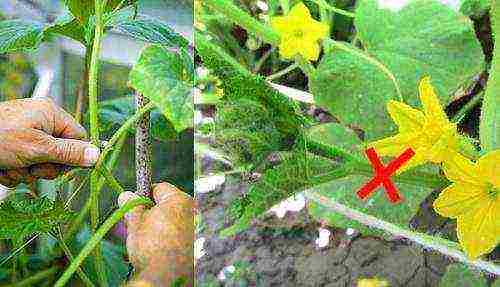
The pinching of parthenocarpic varieties is different from simple cucumbers. Non-hybrid varieties usually begin to form after the fifth leaf, since male flowers are laid on the main shoot.
In parthenocarpites, flowers grow in the same way, but it must be borne in mind that they are feminine, so do not pinch after 5 leaves.
It is better to do the formation in this way:
- in the axils from the first to the fifth leaf, remove the lateral shoots and inflorescences;
- leave the next six side stitches (the length of each should be no more than 25 cm);
- pinch two or three shoots growing behind them, shortening them to 35 cm;
- increase the length of the next three of the lashes by 10 cm, and then also pinch.
The main shoot must be fixed, and when it reaches its maximum length, also pinch it or throw it over the support (so that it grows towards the ground).
In secondary shoots that appear from lateral lashes (not main ones), after the first leaf, the growth point should be removed.
What other reasons can be that the ovaries do not grow?
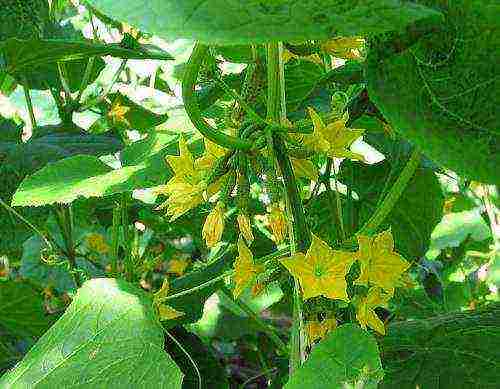
If the bush was formed correctly and on time, and the set fruits still do not grow, the reason should be sought in the following:
- Too many ovaries that the plant cannot “feed”. Solution: remove them before blooming flowers, leaving no more than 30 pieces per bush.
- "Young age" of the plant. Fragile bushes have a weak leaf apparatus, but they can already form lateral shoots with ovaries, but there is not enough food for everyone. Solution: if the bush is not yet strong enough, it is better to remove the first ovaries and give it time to gain strength.
- High air humidity. Solution: ventilate the room more often.
- The room is too hot. Solution: lower the temperature or move the plant to another location.
- Sudden changes in temperature.
- Heavy soil. Solution: feed the cucumbers with growth regulators (Zircon, Epin)
Parthenocarpic varieties of cucumbers during the period of formation and ripening of fruits require weekly feeding, for example, infusion of mullein with urea.
Parthenocarpic cucumbers: popular hybrids - video
What could be better than your own vegetables, plucked immediately to the table! It turns out that this is possible not only in the country, but also in the city. Try growing cucumbers on your balcony. If you use special balcony hybrids, the process will not only be fun, but also simple.
A balcony facing east or southeast is suitable for growing cucumbers. On the north side of the house, the plants will be dark even with additional lighting. If the house is located in a windy place, and the balcony is not glazed, it is better to part with the idea - cucumbers cannot stand drafts.
What needs to be prepared for growing cucumbers on the balcony
Seeds. Be sure to check the description on the back of the package. It should say that this variety / hybrid of cucumbers is suitable for growing on a balcony, shade-tolerant, forms compact fruits, vines have short internodes, does not require pollination (parthenocarpic): F1 Urban cucumber, F1 Balconny, F1 Balagan, F1 Berendey, F1 Courage, F1 Manul.

Balcony flower growing container (80 x 25 cm) - with drainage holes at the bottom and stand for water drainage (look in the flowerpot section). It is best to choose a light color so as not to overheat in the sun.
Universal soil for vegetables -bag 25 l. As a rule, the composition contains high-moor peat with the addition of perlite (vermiculite).
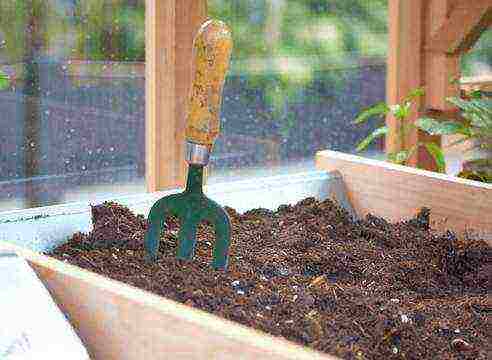
Drainage, you can use small expanded clay.
Liquid Fertilizer Bottle for indoor flowers (1L).
Sprayer for indoor flowers (1L).
Clothesline holder.
A roll of clothesline or twine.
Sowing seeds and growing cucumber seedlings
Cucumber seeds can be sown in April - early May, for a long day, when the plants no longer need to be illuminated. If the cucumbers are planted earlier, budding will coincide with the stay of the plants in the apartment, some of the ovaries will fall off, the vines themselves will stretch out strongly, since it is dark for them in the room, and it is too early to take out the plants to the balcony. Modern hybrids, as a rule, are early ripening - 45-50 days pass from germination to fruiting.
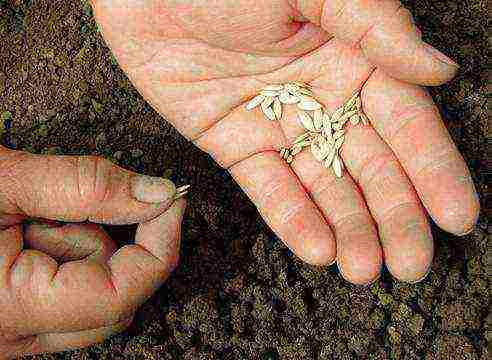
1. How to prepare the soil for sowing cucumbers.
Cucumbers love light, fertile soil. It is best to ask friends-summer residents for garden land or rotted compost, and mix with ready-made commercial soil for vegetables, adding perlite (4: 1: 1) If this is not possible, use ready-made universal soil for growing vegetables with an acidity of pH within 6, 3-6.8. In order for cucumber vines to develop fully, the soil consumption should be about 5 liters per plant. Before sowing seeds for the prevention of diseases, self-prepared soil must be disinfected in any convenient way: steamed over boiling water, spilled with fungicide, heated in the microwave.
Pour the drainage into the bottom of the container in a layer of 2-3 cm. Fill the container with the prepared potting mix, not adding 5 cm to the top edge. Spill soil, top up after shrinkage.
2. How to sow cucumber seeds.
Cucumber sprouts are fragile, it is difficult to sow sprouted seeds, therefore, sowing with dry seeds hardened for 2 days in the refrigerator is preferable. Large growers supply seeds that have already been treated against diseases and pests, so if the seed has a colored shell, it does not need to be disinfected before sowing.
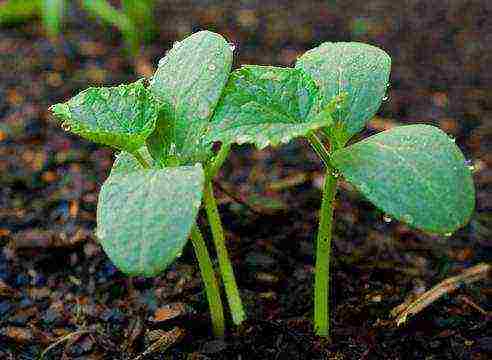
In the center of the container, retreating from the walls to 15 cm, make holes at a distance of 30 cm from each other. To hedge against possible non-germination, sow two seeds per hole. It is not necessary to close the seeds deeply, 1.5-2 cm is enough. Cover the crops with foil, a plastic bag and keep the container on a warm light windowsill at a temperature of + 24 ... + 26 ° С.
3. Growing cucumber seedlings at home.
If all the cucumber seeds germinate, remove the weakest seedling in each hole by cutting off the surface of the soil with a sharp knife, but not pulling out. As the top layer dries, evenly moisten the soil with water at room temperature from a spray bottle (so that the seeds are not sucked in). Seedlings should appear on the 4th-6th day, then the film can be removed. After that, it is advisable to maintain the air temperature at + 20 ... + 24 ° C, and the soil + 18 ... + 20 ° C, so that the plants do not stretch out. Before the onset of stable + 15 ° C, keep the plants at home on the lightest window, water as the top layer of the soil dries up. After 10-20 days, in the phase of 2-3 true leaves, the plants are ready for gradual hardening. To do this, they can be left in the afternoon under an open window at midday in calm weather, taught to direct sunlight, starting from the warm morning hours - around 10-11 am. You can transfer the plants to the balcony when the threat of frost has passed, or you can carefully monitor the weather reports in order to bring the plants into the house in time. When 2-3 true leaves are formed in plants, they can be fed once a week with a solution of liquid complex fertilizer for seedlings.In the 5-leaf phase, water the cucumbers once a week with a half-strength cucumber fertilizer solution until the soil is completely wetted, but not less than 250 ml per plant.
How to tie lashes of cucumbers
In the phase of 5 leaves, it is already difficult for plants without support. To prevent them from breaking under their own weight, as a temporary measure, a plastic trellis for indoor climbing plants can be installed in each container.
The appearance of 6-8 leaves is a signal that the vine needs to be tied to tight ropes. At a height of about 2.5 m (above the raised hand), drill holes in the wall, put the clothesline holder on the self-tapping screws, tie the ropes, leaving one end about 1.5 m long free (it will come in handy to tie up the vines when they grow up), wrap the vines around the taut ropes and reinforce with a weak loop.
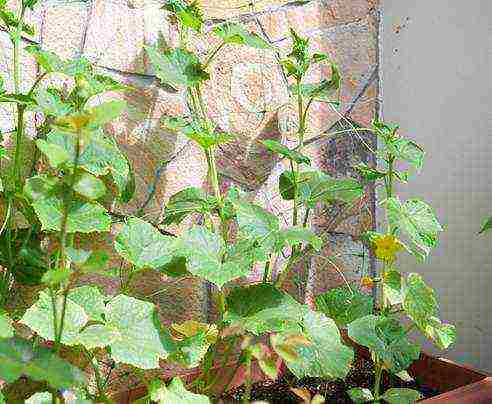
Caring for cucumbers on the balcony
In hot weather (above + 30 ° C), plants need to be shaded from direct sunlight so that the leaves do not burn out. You can increase the humidity if you put a bucket of water next to the plants on the balcony, mulch the soil with moist sphagnum, spray the leaves in the evening and water it daily - cucumbers consume a lot of water. As they grow, the roots will penetrate from the drainage holes into the lower sump, and will actively absorb water from there.
When the vines grow above the place of the garter, they can be lowered a little by untiing the ropes from the support and tied to a new length. You do not need to pinch balcony hybrids, but if they grow strongly, you can pinch in the 10-12 leaf phase.
At the beginning of August (from Elijah the Prophet) for the night it is already necessary to wrap the containers with sacking or spunbond (with a density of 60 g / m2) so that the roots do not overcool, since the difference between day and night temperatures will already be significant. After the end of fruiting (the development cycle of a cucumber is about 90 days), the vines can be cut off, the rhizome can be dug out. Remove the soil from the boxes in plastic bags - it can be used as a base for the next year (only replace half of the volume with new soil), containers and ropes should be washed, rinsed in the Whiteness solution and removed until next season.
